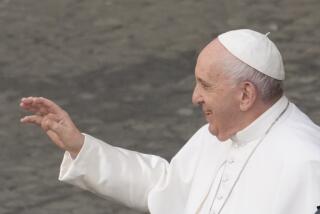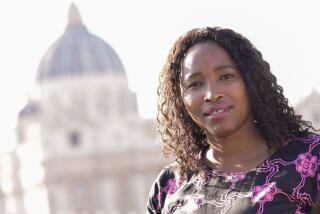Cardinal Proposes Uniform Catechism for All Nations
- Share via
VATICAN CITY — Cardinal Bernard Law of Boston proposed Tuesday at an international assembly of Roman Catholic bishops that Pope John Paul II issue a uniform teaching text for the world’s 800 million Catholics.
The single catechism that Law proposed would replace the present texts devised by each national hierarchy.
“Youth in Boston and in Moscow both wear blue jeans. They listen and dance to the same music,” Law told his fellow bishops. “In a world which becomes ever smaller--a global village--national catechisms no longer respond to the present needs of a clear articulation of the faith of the church.”
Law, the archbishop of Boston, is one of several delegates from the U.S. hierarchy attending a so-called extraordinary synod called by the Pope to discuss the sweeping changes that have occurred in the church since the Second Vatican Council ended 20 years ago.
The synod is an advisory body to the pontiff and cannot set church policy. But the meeting here is certain to shape the thinking and decisions of the Pope and the Curia, the Vatican governing body, in establishing the future direction of Catholicism.
The 16th-Century Council of Trent originally established a universal Catholic catechism, the basic lay teaching materials of the church. But by the beginning of the 20th Century, individual national congregations had devised their own catechisms.
Scheduled Rotation
Law was one of 38 bishops, archbishops and cardinals from five continents who spoke in scheduled rotation at the synod on Tuesday.
“I propose a commission of cardinals for the preparation of a draft of a conciliar catechism which would be promulgated by the Pope after having consulted the bishops of the world,” Law said, according to a summary of his remarks issued by the Vatican.
The reaction of other prelates to Law’s proposal could not be learned because, during the first business days of the synod, other participants cannot make rebuttals or comments to the speeches.
The synod is being attended by 165 voting members, including the heads of the national conferences of bishops. Observers include cardinals who head Vatican departments, invited guests and officials of other Christian churches in theological dialogue with Rome.
The synod is closed to the public. But excerpts of the speeches, given in the Vatican’s ultramodern auditorium adjacent to St. Peter’s Basilica, are made available by spokesmen at twice-daily press briefings.
Further reports and conclusions--and perhaps a final document--will follow before the synod concludes on Dec. 8. The Pope, though present at each meeting, is not expected to speak until the final session, a spokesman said.
Emerging Trends
At a press briefing on Tuesday evening, Father Diamuid Martin, a Vatican spokesman for the English-speaking press, said several trends appeared to be emerging as the bishops attempt to renew the spirit of Vatican II through the synod:
--A strong commitment to the reforms of Vatican II, which modernized the church but also sowed some confusion and doubt among the faithful. “There is a more realistic assessment of the difficulties,” Martin said, but “without a mood of pessimism.”
--A deeper understanding of “collegiality,” the principle by which the bishops and the Pope collaborate in governing the church. At least four bishops, including the head of the U.S. hierarchy, have proposed that local bishops and their national organizations be given greater influence in the operations of the church.
--”A universal call to holiness,” in which Catholics seek stronger spiritual awareness. “This is what will give life to the church,” Martin said.
--A greater emphasis on preaching the Christian message in order to make converts and extend the church’s mission.
Martin also said that the inroads of “secularization and atheism” in society pose the biggest threat--and challenge--to the church.
More to Read
Sign up for Essential California
The most important California stories and recommendations in your inbox every morning.
You may occasionally receive promotional content from the Los Angeles Times.










